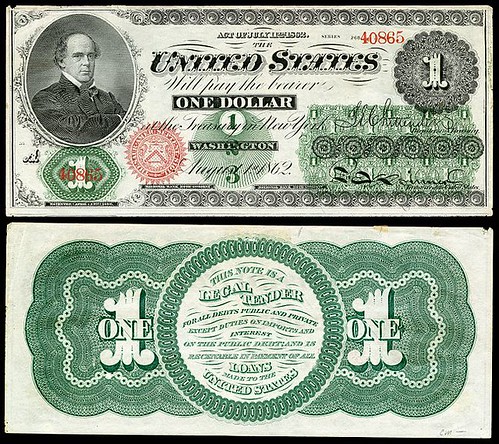
PREV ARTICLE
NEXT ARTICLE
FULL ISSUE
PREV FULL ISSUE
THE DECISION TO ISSUE GREENBACKSPablo Hoffman passed along this Delancey Place blog excerpt from the book Ways and Means by Roger Lowenstein. Thanks! -Editor
"In the desperate winter of 1861-1862, the financial crisis threatened to halt the Union armies. The Treasury was empty; the banks had suspended; the government had no currency. Chase had few ideas, other than a labored program for bank reform. Almost by default, the Republican Congress seized the initiative. The most likely vehicle for financial resuscitation was the House Ways and Means Committee. Ways and Means had two subcommittees. One dealt with revenue, but revenue legislation was unlikely to provide help in the near term. The other subcommittee, on currency, was chaired by Elbridge Spaulding of New York State. Spaulding had been working on Chase's proposal to reform the banks, but when the banks went off gold, Spaulding realized there would not be time. He himself was an investor and director in Bank of Attica and the Farmers and Mechanics' Bank, both in Buffalo. In the 1860s, it was not uncommon for representatives to tailor legislation affecting personal investments. Spaulding, who had been a popular Whig mayor before running for Congress, was untroubled by any idea of conflict of interest. He simply reckoned that the banking channel was stuck and it was in the public interest -- also in his private interest -- to unstick it. On December 30, 1861, with the Union nearly overwhelmed by fiscal problems, Spaulding reported another bill -- for a government currency. "In theory, Spaulding could have proposed more of the Treasury demand notes, but as we have seen, the demand notes were refused in some quarters. Spaulding wanted a universally acceptable currency that the Treasury could use to pay for the war. His bill was revolutionary. As if by a conjurer's trick, it authorized the Treasury to print United States Notes to distribute to soldiers, suppliers, and others. The catch was that, unlike virtually every other bill in circulation, Spaulding's notes would not be redeemable for silver or gold. This meant the government would not be constrained by the supply of metal; it could print as much as it liked, or at any rate as much as Congress authorized. "And Spaulding's notes would not pay interest. Today, we scarcely pause to consider that the money in our wallets does not yield a return. After all, it is 'money.' In 1861, virtually all government paper did pay interest. That was the inducement for holding it. Finally, Spaulding's paper would not have a maturity date. This, too, was unusual. A maturity date was a pledge that the paper could be exchanged for something of value at a specified time. But these notes would not be redeemable. They were issued for perpetuity. "To the Civil War mind, these features were both shocking and blasphemous. Several years before the war, a Boston merchant named Samuel Hooper had published Currency or Money, a tract that had considered -- and denounced -- such a currency. Hooper did not mince words. 'They [paper bills] are not money,' he wrote disdainfully. 'They are, in fact, only promises to pay money.' The son of a shipper in Marblehead, Massachusetts, Hooper had learned finance at a countinghouse on State Street in Boston, and then become a prosperous businessman, trading in the Pacific Northwest and China. A savvy appraiser of financial risk, he had written that paper money was no more like the real thing than a contract to deliver flour was flour itself 'Paper money possesses no intrinsic value,' Hooper had patiently explained. 'It has only a derivative or secondary value, founded upon the good credit of those who issue it.' "What, then, was Spaulding proposing to offer-if not an interest payment and not redemption at a maturity date -- to induce people to take his currency? Spaulding's U.S. Notes would be 'legal tender' they would be money by proclamation, that is, by government fiat. They would suffice for all debts and commercial exchanges; acceptance would be compulsory and universal. "The legal tender debate was among the most profound of the war. Opponents maintained, and firmly believed, that issuing paper would cause a ruinous inflation. Thus far, inflation in the North had been relatively modest. But legislators were well aware that war currencies had come a cropper in the past, including in America during the Revolutionary War and in Britain and France during the Napoleonic era. Congressmen frequently quoted the Founding Fathers; all had been skeptical -- if not dead set against -- paper money.
To read the complete article, see:
To read the earlier E-Sylum article, see:
Wayne Homren, Editor The Numismatic Bibliomania Society is a non-profit organization promoting numismatic literature. See our web site at coinbooks.org. To submit items for publication in The E-Sylum, write to the Editor at this address: whomren@gmail.com To subscribe go to: https://my.binhost.com/lists/listinfo/esylum All Rights Reserved. NBS Home Page Contact the NBS webmaster 
|


